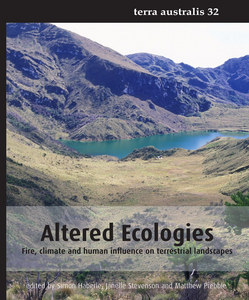Integrating social and environmental change in prehistory: a discussion of the role of landscape as a heuristic in defining prehistoric possibilities in northeast Thailand
Boyd, William E., and Chang, Nigel (2010) Integrating social and environmental change in prehistory: a discussion of the role of landscape as a heuristic in defining prehistoric possibilities in northeast Thailand. In: Haberle, Simon, Stevenson, Janelle, and Prebble, Matthew, (eds.) Altered Ecologies : fire, climate and human influence on terrestrial landscapes. Terra Australis, 32 . ANU E Press, Canberra, ACT, Australia, pp. 273-297.
![[img]](https://researchonline.jcu.edu.au/18358/2.hassmallThumbnailVersion/18358_Boyd_and_Chang_2010_front_cover.jpg)
|
Image (JPEG) (Book Cover)
- Cover Image
Download (233kB) |
|
|
PDF (Published Version)
- Published Version
Restricted to Repository staff only |
Abstract
The archaeological study of past societies is an inherently difficult activity. Relying on extremely small samples of the available evidence, often many millennia after the event, archaeologists have the unenviable task of inferring complex relationships and processes for societies whose social, cultural, political and cognitive characteristics are likely to be very different from those of the archaeologists investigating them. Consequently, archaeologists are developing and adopting an increasingly wide range of analytical and conceptual tools with which to tackle the task of unravelling past social behaviour and history. While palaeoenvironmental study has frequently been called on, it has been largely to provide an assumed passive background, a stage on which people have enacted their social and cultural activity, or a resource providing the essential energy and materials for a successful society, merely at risk of being degraded by the very societies which rely on that resource. However, there is a growing and vibrant literature that promotes the truism that people and environment are intimately linked. Building on this close relationship, geographers, in particular, recognise landscape as a crucial unifying element, a phenomenon that both recognises and reflects the mutual interactivity of people and their environment. In this paper, we discuss the heuristic of the landscape as a source of evidence in assisting in defining social possibilities in the past. By doing this, we recognise both archaeological and geoarchaeological data as equal sources of data reflecting past social behaviour. We use an example from northeast Thailand – the Neolithic to Iron Age occupation of the upper Mun River valley – to demonstrate the potential that such an integrating approach may have for furthering our understanding of past social behaviour. In particular, we focus on a crucial event towards the end of the Iron Age, in which the choice of a re-patterning of settlement across the landscape, while conventionally being understood as an obligatory response to either environmental degradation or an inevitable socio-political progress, can be better explained as a unique and non-obligatory response to a particular set of socioenvironmental conditions, emerging from a history of evolving social identity intimately associated with the landscape of the previous 2000 years.
| Item ID: | 18358 |
|---|---|
| Item Type: | Book Chapter (Research - B1) |
| ISBN: | 978-1-921666-81-0 |
| Date Deposited: | 11 Oct 2011 04:23 |
| FoR Codes: | 21 HISTORY AND ARCHAEOLOGY > 2101 Archaeology > 210103 Archaeology of Asia, Africa and the Americas @ 100% |
| SEO Codes: | 95 CULTURAL UNDERSTANDING > 9505 Understanding Past Societies > 950502 Understanding Asias Past @ 100% |
| Downloads: |
Total: 493 Last 12 Months: 4 |
| More Statistics |



